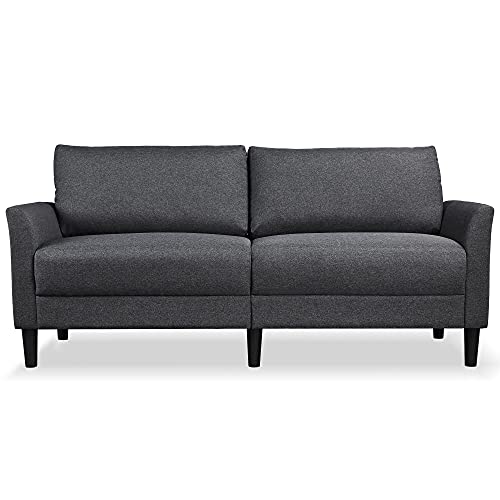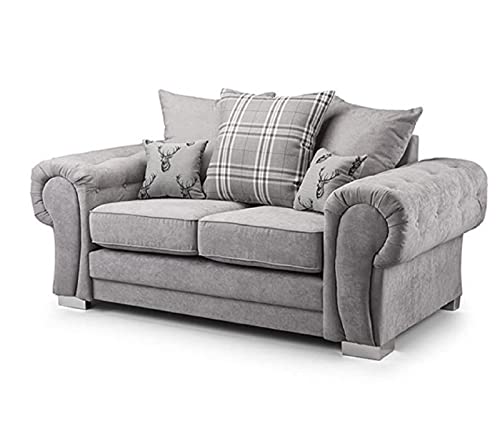Guide To 2 Seater Leather And Fabric Sofa: The Intermediate Guide For …
페이지 정보
작성자 Shoshana 작성일24-12-13 06:33 조회4회 댓글0건관련링크
본문
 Choosing Between a 2 seater leather And fabric sofa (wikimapia.org)
Choosing Between a 2 seater leather And fabric sofa (wikimapia.org)It can be difficult to decide between leather and small fabric 2 seater sofa when you are looking for a new sofa. This is especially the case if you don't have a lot of furniture experience.
If you have kids or live in a smaller apartment the leather option might be the best option for you. It is easy to maintain and looks gorgeous in a lot of homes.
Comfort
The sofa is usually the focal point of homes and is an important purchase. You want one that you can sit on for hours and looks good, is in line with your decor and can stand the test of time. It isn't easy to choose between leather and fabric, but you should consider your budget, lifestyle, and other priorities before making a choice.
Leather is a luxurious, premium material that radiates style and elegance in any home. It is tough, stain resistant, safe for pets and children and can last for a long time with proper maintenance. However, it can be more expensive upfront and may require regular conditioning to prevent cracking or peeling.
fabric 2 seater sofa sofas come in a huge variety of styles, colors and fabrics. They are a more affordable choice than leather ones. They are also softer and more inviting, and can be "broken in" right from the beginning. They could be more vulnerable to dust mites and hairs from pets and require frequent cleaning. However, with new technology and performance fabrics there are now hypoallergenic options to choose from.
Fabric sofas can last up to 15-years if they are well maintained. Regular vacuuming and deep cleaning will ensure that the fabric is free of stains, odours and dirt. Like leather, they can be prone to sagging and flattening over time. Additionally, many fabrics have been treated with chemical to make them stain-resistant as well as flame retardant. These chemicals can release volatile organic compounds that may alter the quality of air in the indoor environment and cause allergies.
Durability
When purchasing sofas, we usually opt for fabrics that are extremely durable because this can be essential when you have pets or children. You don't want to pay a lot upfront and be left with buyer's remorse after the first spill or crowbarred claws. Also, you don't want to purchase a product that isn't expensive but doesn't stand up to everyday use.
Leather, on the other hand, is extremely resilient and has a remarkable tear strength. It can last up to four times longer than fabric and is innately resistant against cracking, fading, and flaking. It can also be treated to replenish its natural oils, and look as fresh as new.
Fabrics are less expensive and come in many different patterns, colors, and textures that can be adapted to any design scheme. They are also easier to clean than leather and can withstand a decent amount of wear and tear, however they tend to be more susceptible to moisture and fade in time.
Microfiber is durable and comes in a variety of colors. However, it may not be as sturdy as genuine leather. It may also not be able to take scratches. It is still a great choice for families because of its resistance to spills and stains. It's also simple to clean with a damp cloth.
Suede is more difficult to clean and repair than leather. It is also prone to losing its shape if it is not regularly conditioned and can feel quite rough to the touch. It is also a thin product and therefore may not be as tough as sheepskin or cowhide.
Allergens
Fabrics can have a significant impact on allergies. It is crucial to know the way different options work. Fabrics are known to hold allergens like dust mites, pet dander, and mold that can trigger symptoms of nasal allergies, hay fever eczema and asthma. This is because these fabrics provide the perfect environment for them to fester.
Leather, on the other hand, is not prone to accumulating allergens and provides constant comfort no matter what season it is. However, it can cause dermatitis, particularly in those suffering from contact dermatitis and are sensitive to the chemicals used in tanning. Using vegetable-tanned leather and maintaining an active skincare routine is essential to reduce skin reactions.
Leather and fabric sofas both offer a high degree of durability, however the material you choose will determine the degree to which it can last over time. A top-quality fabric will stand up to the demands of daily usage without fading or sagging and will be able to endure spills and body oils with ease. Many modern fabric sofas even come with stain-resistant treatments that make cleanup effortless.
It is not possible to completely prevent an allergic reaction to the leather in your sofa however, you can avoid allergens if you keep an lint-roller in your home and clean regularly your living space. This will help reduce the amount of dirt, pet hair and dust mites that are a nuisance on your sofa. If you're still suffering from allergies, you should consider swapping your sofa for a more hypoallergenic model. For instance, a sofa made of vinyl or synthetic leather is less likely to keep dust or pet dander out of the mites. It will also make it easier to breathe.
Scratches
It is crucial to think about the amount of wear you can anticipate a leather couch to endure. The finish, colour and quality of the leather are all crucial aspects in how long a couch will last. You should also make sure it's sturdy enough to withstand spillages or other accidents. This can be done by choosing a couch with a solid wood frame and high density foam cushions.
Leather is susceptible to being scratched due to many reasons, such as stretching or marking territory, or even the reliving of the stress. Scratches can vary in severity, from minor surface scratches to deep cuts and punctures. Minor scratches can be repaired by applying a conditioner for leather to the area affected. This will restore the balance between moisture and oil in the leather and stop it from drying out or cracking. The extent of damage will determine the treatment needed.
If you have cats, it's recommended to trim their nails on a regular basis as this can help to prevent them from scratching your couch. You can also redirect your cat's scratching habit by offering alternatives to scratching surfaces, such as sisal rope or cardboard. Another option is to apply a pet-safe furniture polish that can be applied with an abrasive cloth to the affected area.
In addition to cleaning your leather sofa regularly, it's recommended to keep it away from the direct sun and other sources of heat, as this can dry out the leather. This could cause it to crack and is often difficult to repair and usually requires reupholstery. Use a conditioner for leather as well to keep the leather soft.
Smell
A leather sofa is likely to have a distinct scent than fabric. It's because leather is porous, and can absorb odors such as smoke, body odors, or food. The good news is that odors usually dissipate over time, especially if you use a non-toxic, fragrance free cleaner.
If the smell is strong It could mean that something is wrong with the foam. This is typically caused by the chemical off-gassing process of polyurethane, which is a petroleum-based derivative. If you're worried about this, you should look for couches made of CertiPUR US certified latex foams or natural latex.
Another way to identify fake leather is to look for bumps or texture on the back of the sofa. This is a sign that the leather and fabric 2 seater sofa is not genuine top grain. You can also conduct an inspection by tilting the couch to its side to see if it's possible to see any exposed upholstery backing. If you smell it, it's probably a synthetic substance like polyurethane or polyester. These types of materials are likely to have a different smell than leather.
While a leather couch is more susceptible to picking up odors, the best way to prevent this is to clean regularly your sofa. This keeps it looking good and fresh and will also stop it from becoming stiff or cracked over time. Start by vacuuming and dusting, then wiping the couch with baking soda (a natural method to get rid of odors). This is to be done every two weeks to remove dust and dirt. Apply leather conditioner to preserve the appearance and color of your sofa.

댓글목록
등록된 댓글이 없습니다.
